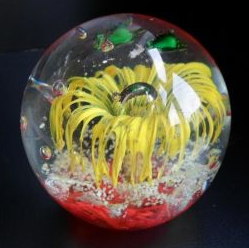This video features many of the 400 weights displayed in the Corning Museum of Glass with an emphasis on those made by French 19th century factories. Also shown are techniques of millefiori, lampworking, sulphides, and crimping, as well as footage of how weights are made today. Included are views of paperweight making at Baccarat, Saint-Louis, Wheaton Village, and the studios of Paul Stankard and Victor Trabucco.
The Crown Jewels
The Crown Jewels -- Glass Paperweights
By Art Elder
“The Crown Jewels for Collectors” — that’s what Paul Hollister wrote about fine glass paperweights. He was one of the foremost scholars of 17th to 19th century glass studies, glass paperweights, and contemporary studio art glass. Paperweights are considered the most collectable of 19th century glass items, and also the most challenging of the glass arts to make. Fine glass paperweights are, indeed, rare treasures.
Most antique paperweights of quality were made by one of three French factories, as a sideline, for just 10-15 years in the mid-1800s. It’s estimated that only about 25,000-30,000 remain today, with many tightly held in museum collections. Fine contemporary paperweights are made by a limited number of studio artists and are sold either by the artist, or by a small group of specialty dealers.
History
The mid-to-late 1800s were sentimental and romantic times, heralded by an emerging middle class, resulting from the matured Industrial Revolution. Letter writing became a fad, and paperweights were sold in stationery stores as an attractive accessory to desk-sets of pens, inkwells, blotters, and fine stationery. The first glass paperweight was made in 1845 by Venetian glassmakers in response to the letter-writing fad. They could have been made 300 years earlier because the techniques were known, but paper was then a rare commodity and there was no need for a paperweight. They are the perfect example of form following function.

The finest were made by the French factories of Baccarat, Clichy, and Saint Louis for only 10-15 years. By 1855-1860, their production in France sharply fell off as the factories moved on to produce other objects.
Read More
Cathy Richardson Demonstration
A behind the scenes look at Cathy Richardson Paperweights, which is located along the Mississippi River in Winona, Minnesota. This piece was shot and edited for KSMQ's "Off 90"
Craft In America interview with flamework glass artist Paul Stankard segment. ORIGINS episode PBS premiere: October 7, 2009.
What is a Paperweight?
What is a Paperweight?
by Steve Richardson, PCA Outreach Director
If you have been collecting for even a short time, you have probably heard that question a few times. If you haven’t heard it out loud, you’ve at least run across people who give you a blank stare of polite puzzlement when you tell them what you collect in your spare time.
 The confusion starts with the word “paperweight” itself. Even the earliest modern paperweights were designed more as decorative objects than as utilitarian tools to keep papers from blowing off your desk. It might have been more helpful to refer to them as glass sculptures or miniature worlds or – as some artists today call them – orbs.
The confusion starts with the word “paperweight” itself. Even the earliest modern paperweights were designed more as decorative objects than as utilitarian tools to keep papers from blowing off your desk. It might have been more helpful to refer to them as glass sculptures or miniature worlds or – as some artists today call them – orbs.
 The more fundamental problem, though, is that many things have been called paperweights. There are also many small objects – think snow globes or pet rocks – that fit the broad definition of being mildly artistic and commonly found on desks. I find it difficult to explain why those don’t belong in my paperweight collection, at least without sounding a bit snobbish.
The more fundamental problem, though, is that many things have been called paperweights. There are also many small objects – think snow globes or pet rocks – that fit the broad definition of being mildly artistic and commonly found on desks. I find it difficult to explain why those don’t belong in my paperweight collection, at least without sounding a bit snobbish.


Part of the problem is that we each have personal feelings about what is “artistic”. We build a mental hierarchy that includes everything from the Mona Lisa to our grandchildren’s refrigerator art, and we draw a line that puts pet rocks on one side and real paperweights on the other. Another part is that many objects that PCA members collect are, frankly, expensive. They are items that people buy with discretionary income. If you have collected even a few costly paperweights, you may appear to be in different circumstances than people who can only afford snow globes. This is very delicate territory, particularly when we are debating about where mass-marketed Chinese weights and some Murano weights fall in the spectrum.




